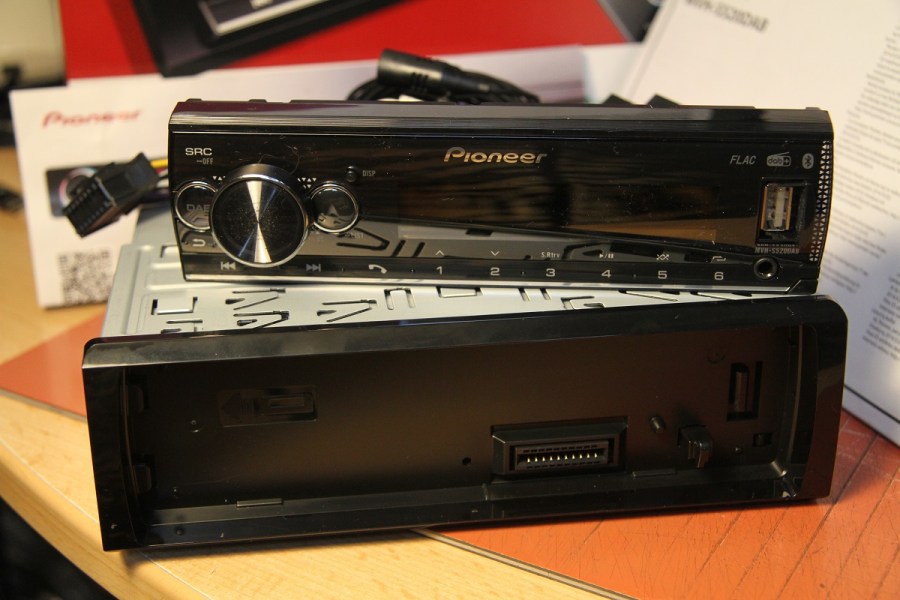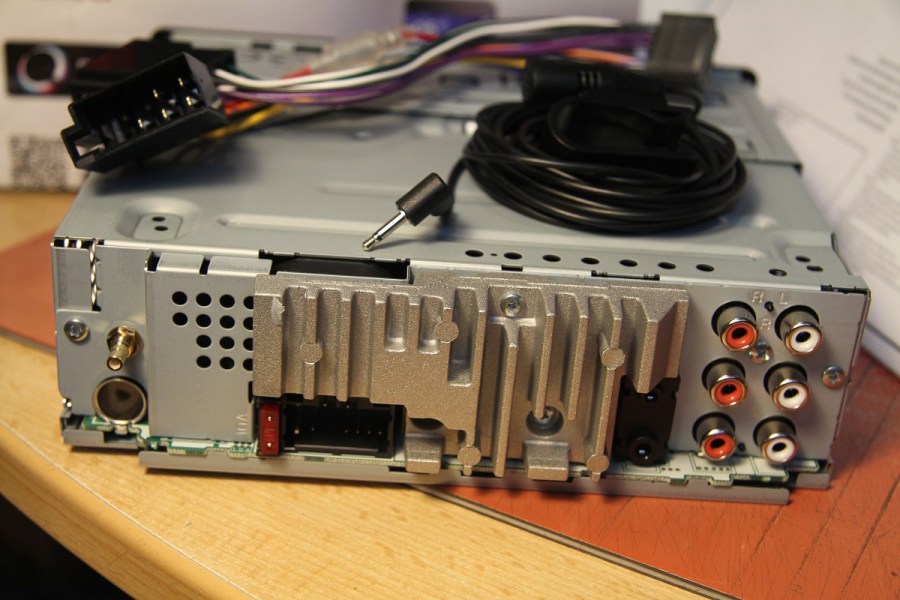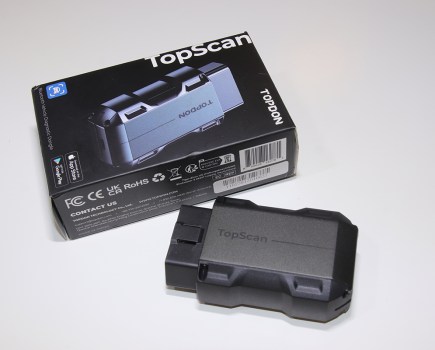RRP: £149.99. Buy it here. (Not available in the US, try the MVH-S520BT instead, RRP: $159.99)
Pioneer are the OG brand of car audio. There was a time when I was a sales rep in car electronics for Electrosystems, which was profoundly educational about the industry. It meant visits to car audio stores and to oily fitting bays where they fixed your bulbs and fuses. And while some had names like Autosound and Auto Audio (both still big operations) many were just “Joe’s 12V Sparks”. But no matter how small the business, if they had a waiting area, there was a Pioneer car radio stand. So, as you can imagine, I was keen to conduct this Pioneer MVH-S520DAB review to see if they really are still the brand to beat today.
Pioneer were the very first to do ‘component’ car audio with their legendary Centrate units. It was 1983 and by 1984 they had released the world’s first in car CD player. So they know what they are doing.
Pioneer care about sound quality. I was flown to ‘Vegas to the SEMA show with Pioneer once. The main thrust was their new units’ new feature, something called ‘ASR’ for Advanced Sound Retriever, which had emerged before other systems like it. It takes the music file in MP3 or whatever, analyses the high frequency content and interpolates a high frequency zone. It literally adds back in the breathiness and even psycho-acoustic highs we are not supposed to be able to hear. But it is proven that we can tell. Super tweeters as they are called, play way over 20kHz and make stuff sound sweeter. The HiRes specification goes way up higher than 20kHz. Pioneer did it first. JVC call their version, ‘Sound Response’ and it also interpolates highs to add back in. Pioneer’s version that also works over Bluetooth is called Sound Retriever Air.
That historic prowess does indeed seem to remain within the MVH-S520DAB. It’s a lovely-looking, easy to use mechless media player-radio with real smarts for the money asked. Keep reading to find out more…
Setup and operation
The display is handsome if not that major in element-count. It is all about the scrolling text as well as that crazy color customization LED backlighting. The menu system is easy to use. You twist and press, like so many do. I plugged in the USB and AUX and the window-mounted DAB aerial and my FM twig.
I admit that I got a bit flustered on take one of the little video clip I like to make though, having managed to confuse the unit until it didn’t show Spotify as a source option. It also said NO SIGNAL on the DAB. Puzzled, I phoned Team Impulse in Watford, my local experts, to see if they might advise me. I was certain that I needed an adaptor to get DAB. He put me right and explained the whole SMA/SMB screw-down versus push-fit DAB plugs and sockets thing by market. I powered down the Daiwa power supply which looked like the battery has been disconnected to the radio. It reset, tuned itself to the DAB stations and once again showed that I could play Spotify as a source.
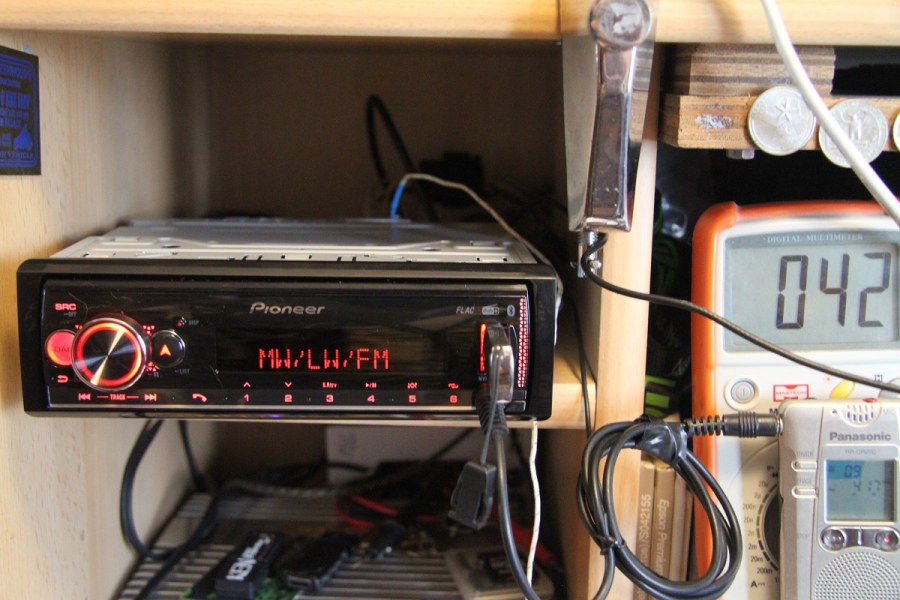
It also had BT Audio for Bluetooth sounds. I was a bit confused, as to play Spotify, I just paired the unit, which was fast and easy. It sounded great and scrolled the track title of my restricted, free Spotify account. Firing up YouTube and the video title, then channel name, scrolled across the screen. But I just could not get the app to connect to the radio. Frustrating but it’s about apps, not the radio, I reckon.
It read and text-delivered on the USB stick as soon as I plugged it in. The Aux proved to be clean and loud, so my 28 year old can be heard, as a toddler, singing.
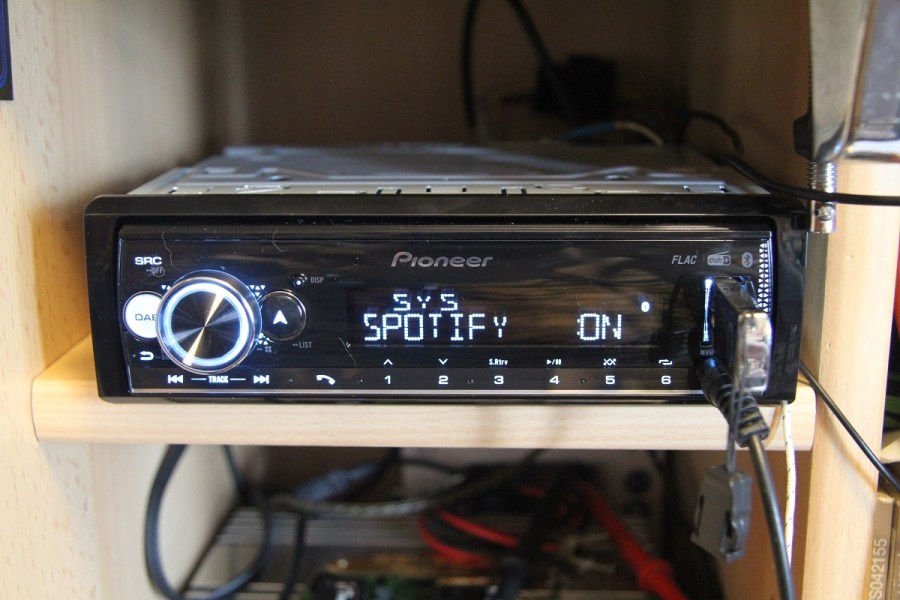
How well does it work?
The features for serious sound control make this a contender for bossing a truly hench system. The front and rear speaker outputs can be crossed-over so the deep bass is kept from speakers that will waste energy trying to reproduce them. There is a choice of frequencies from 50Hz and up. That’s great for removing deep stuff from say, rear six-inchers, to make them hit harder. You can run four inchers much louder if you cross them high-pass at 200Hz.
There is also control for that subwoofer RCA output. Alternatively, set the three sets of RCAs up as a fully digitally crossed-over network of outputs. No amplifier to feed? You can still do the subwoofer drive thing by internal speaker power. I recall Pioneer doing this first. Others have copied it.
The rear speaker wires can be set to just run bass. You need a 2 ohm woofer and it will get 70W! The others I have seen do this manage a 1x50W into a 4 Ohm subwoofer. Heard at a trade show, this does make some bass with a big old speaker. Look for one with low power handling and high efficiency. (e.g. 98dB/1W/1M and up) A JL Audio W0 15 would be hilarious to see how loud and deep it gets. Alpine sell an active bass box that only uses a head unit chip amp. And it works and sells well.
A real peach of an easy-to-understand unit, with lovely sound. I just think I shouldn’t have set the ASR so high. The ASR Air function doesn’t show on the display, separately settable, but I definitely made the YouTube track over bright on Bluetooth!
Truly cute, great looks, pity about no face case… but heartily Fast Car Approved.
Tech specs:
- 1-DIN mechless DAB+/FM/MW radio with USB/Aux/Bluetooth streaming and calls
- Onboard Power: 4x50W MOSFET, or 2x50w + 1x70W @2 Ohms sub drive
- 13 band EQ, with two user settable memories, Time alignment, speaker type settings
- Front, Rear, Subwoofer RCA outputs, which can be configured as three-way crossover outputs
- Works with Spotify, also works with iPhone 5 to iPhone X
- Uses Pioneer SmartSync app, which opens up detailed crossover control and more and even adds Alexa
- ASR Advanced Sound Retriever, enhances upper frequencies by interpolation. (Like JVC ‘Sound Response’)
- Customizable 200,000-colour illumination, plays MP3, WMA, WAV, AAC, FLAC
Want to view other options? Check out our single-DIN car stereo group test.

